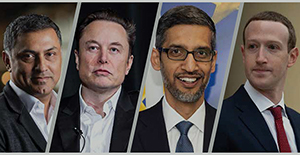DIGITAL COLOUR DIVIDE
In a hyper-connected world, even something as small as an emoji can reveal whose perspectives shape global culture—and whose remain absent. Must every gesture, whether a wave, a clap, or even a heart, carry the weight of identity?
Race, Power, and Diaspora Realities
 Consider the Indian-origin communities in South Africa, where apartheid-era racial categories continue to shape social narratives. In such a context, even a digital skin tone can carry political implications. As Durban-based Professor Dasarath Chetty, a distinguished South African academic, reflects: “What you reflect on is particularly true in a race-based society like South Africa where perceived racial identity was and still is the marker of status, privilege and power. The emoji certainly forces identity declarations, whether ‘real’ or perceived, and as you rightly point out serves to further screen, fragment, reduce and confine. It is actually the antithesis of the inclusivity and cohesiveness it is purportedly meant to foster. I say real or perceived because in South Africa, Africans, Coloureds and Indians who were disenfranchised were and still are in terms of the law ‘Black’—a political concept denoting the dual characteristics of oppression and resistance to it.”
Consider the Indian-origin communities in South Africa, where apartheid-era racial categories continue to shape social narratives. In such a context, even a digital skin tone can carry political implications. As Durban-based Professor Dasarath Chetty, a distinguished South African academic, reflects: “What you reflect on is particularly true in a race-based society like South Africa where perceived racial identity was and still is the marker of status, privilege and power. The emoji certainly forces identity declarations, whether ‘real’ or perceived, and as you rightly point out serves to further screen, fragment, reduce and confine. It is actually the antithesis of the inclusivity and cohesiveness it is purportedly meant to foster. I say real or perceived because in South Africa, Africans, Coloureds and Indians who were disenfranchised were and still are in terms of the law ‘Black’—a political concept denoting the dual characteristics of oppression and resistance to it.”
 Adding to this conversation, Kuala Lumpur-based Gunasekaren Sreerangan, President, GOPIO International (Malaysia), highlights: “The emoji dilemma highlights how even digital design can unintentionally burden Indian diaspora communities with questions of race and identity. Emojis meant to express warmth often force subtle choices of self-representation. What was designed as inclusion can instead feel like pressure. A neutral, raceless choice would allow communication without constant self-consciousness. People should connect freely. Creating space without the weight of racial in every small interaction is important.”
Adding to this conversation, Kuala Lumpur-based Gunasekaren Sreerangan, President, GOPIO International (Malaysia), highlights: “The emoji dilemma highlights how even digital design can unintentionally burden Indian diaspora communities with questions of race and identity. Emojis meant to express warmth often force subtle choices of self-representation. What was designed as inclusion can instead feel like pressure. A neutral, raceless choice would allow communication without constant self-consciousness. People should connect freely. Creating space without the weight of racial in every small interaction is important.”
 Adding another layer of perspective, Cincinnati-based Ashish Chatterjee, Executive Sustainability Advisor, offers a more pragmatic approach: “I use emojis to convey my emotions, not my identity. A thumbs-up means I like the content, so I don’t search for a specific color that matches my skin tone. I usually choose the default color for this reason. However, I respect those who prefer to match their skin tone to the emoji as a way of expressing their identity and emotion. Overall, I don’t think the color of my emoji is relevant to assessing content.”
Adding another layer of perspective, Cincinnati-based Ashish Chatterjee, Executive Sustainability Advisor, offers a more pragmatic approach: “I use emojis to convey my emotions, not my identity. A thumbs-up means I like the content, so I don’t search for a specific color that matches my skin tone. I usually choose the default color for this reason. However, I respect those who prefer to match their skin tone to the emoji as a way of expressing their identity and emotion. Overall, I don’t think the color of my emoji is relevant to assessing content.”
In Trinidad, Guyana, and Suriname, where Indo-Caribbean communities have been blending with African, Chinese, and Indigenous populations for generations, the idea of a single “representative” tone becomes almost absurd. In Brazil or Mexico, where racial identities are inherently fluid but still socially charged, a person of Indian heritage may find no emoji shade that fully represents their lived reality.
In North America and Europe, the challenge takes on another form. In societies acutely aware of race, a brown emoji can mark a user as visibly non-white. A lighter tone may be seen as assimilationist—or worse, as self-denial. In Scandinavian nations, where Indians are often numerically minoritised, emoji choices can quietly underscore cultural difference. And in post-colonial European spaces, where race is both suppressed and implied, even a digital hand can be read as a cue.
 All of this is to say: the act of sending an emoji, for many Indians abroad, is no longer casual. Or as Moscow-based Sammy Kotwani, President of the Indian Business Alliance, observes from his work with diaspora communities: “What should be a gesture of warmth becomes a reminder of difference. Technology must liberate, not burden, identity. A neutral option would restore emojis to their true purpose—universal connection beyond categories.”
All of this is to say: the act of sending an emoji, for many Indians abroad, is no longer casual. Or as Moscow-based Sammy Kotwani, President of the Indian Business Alliance, observes from his work with diaspora communities: “What should be a gesture of warmth becomes a reminder of difference. Technology must liberate, not burden, identity. A neutral option would restore emojis to their true purpose—universal connection beyond categories.”
The Trouble with Inclusion by Design
To understand how this situation came to be, one must look at the Unicode Consortium, the international body that standardises digital characters. In 2015, under growing pressure to address racial representation in emojis—most of which, until then, were white or yellow—it introduced five skin-tone modifiers based on the Fitzpatrick scale, a system originally developed for dermatology, not sociology.
The goal was inclusion. But the method was flawed
By adapting a clinical classification of skin tone to symbolise cultural identity, Unicode and the tech giants that implemented its standard made a critical mistake: they assumed that representation equals choice. But when the choice itself becomes an obligation—a prompt that appears every time one gestures digitally—it ceases to be empowering. It becomes performative.
No doubt, emojis can serve as mirrors of the world. But must people be asked to confront their racial identity each time they wave, clap, or send a heart?
 Amsterdam-based Ryan Tewari, a prominent member of the Sarnami Hindustani community and President of the Global Indian Organization, reflects on this broader cultural dimension: “Most innovations in digital representation, including emoji skin tones, have emerged from a Western-centric technological mindset. One can only imagine how diverse and nuanced these choices might have been had they originated from Asia. Observing this reminds us that global cultural expression thrives when non-Western perspectives play a more active role, bringing richer diversity to the ways we see and represent each other.”
Amsterdam-based Ryan Tewari, a prominent member of the Sarnami Hindustani community and President of the Global Indian Organization, reflects on this broader cultural dimension: “Most innovations in digital representation, including emoji skin tones, have emerged from a Western-centric technological mindset. One can only imagine how diverse and nuanced these choices might have been had they originated from Asia. Observing this reminds us that global cultural expression thrives when non-Western perspectives play a more active role, bringing richer diversity to the ways we see and represent each other.”











Comments.